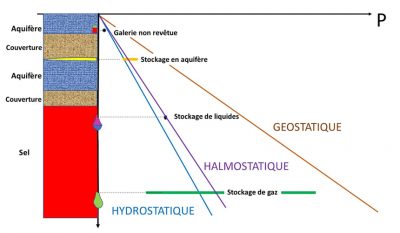Pressures and temperatures in underground storage
PDFAt the ground surface, atmospheric pressure and ambient temperature determine the conditions of thermodynamic equilibrium. At depth, stresses in the rock and natural fluid pressures are much higher. These conditions are favourable to the storage of large quantities of fluids, and especially gases, which occupy a volume that is due to the opposite of pressure. At a depth of 500 m, the volume occupied by the same mass of gas is 50 times smaller than on the ground surface.
Similarly, the natural (“geothermal”) temperature increases with depth. The geothermal gradient is in the order of dT/dz = 0.03°C/m. At a depth of 1000 m, the temperature can be in the range of 40 to 45°C. Above 800 metres in depth, natural pressure and temperature are higher than their critical values for CO2 (31°C and 7.4 MPa), which makes it possible to store it in a particularly dense form.
More specifically, a sedimentary basin consists of a succession of porous and permeable layers (aquifers) and less permeable layers (aquitards). The pressure of water contained in aquifers is generally close to the hydrostatic pressure counted from the surface, where γw = 0.01 MPa/m is the volume weight of water. Geostatic pressure, where γT = 0.023 MPa/m (typically) is the average volume weight of the soil, should never be exceeded by the stored fluids due to the risk of fracturing. Halmostatic pressure (γh = 0.012 MPa/m) is the pressure in a column filled with saturated brine leading to the atmosphere.
The quantities noted “γ” are called “ gradients ” and, by extension, the gradient of the stored products is defined at a specified point by dividing the pressure of the fluid at that point by its depth, which allows to set rules independent of the depth.

The gas pressure in an aquifer storage varies between the hydrostatic pressure, at low stock, and a maximum gradient of 0.015 MPa/m, at full stock.
In a saline cavity for storing liquid or liquefied products, the pressure (constant, excluding testing and maintenance) is halmostatic, i.e. 0.012 MPa/m. Thus, if propane is stored in the biphasic state in an uncoated gallery, it is stored in the liquid state in a salt cavern, generally deeper.
In a salt cavity for natural gas storage, the maximum pressure is about 0.018 MPa/m ; the minimum pressure is about 0.002 to 0.006 MPa/m, depending on local circumstances.
References and notes
Cover image. Increase in pressure with depth; freedivers must be able to withstand it. [Source: pixabay. Royalty-free image]




